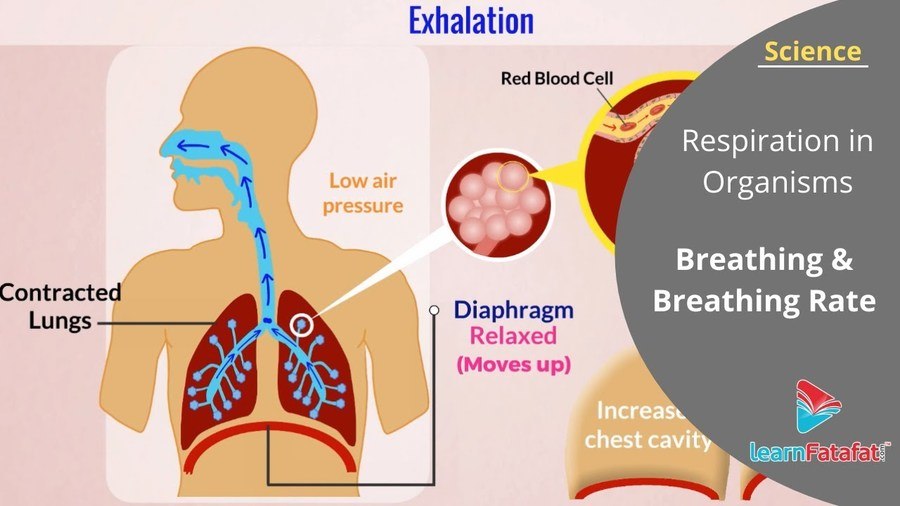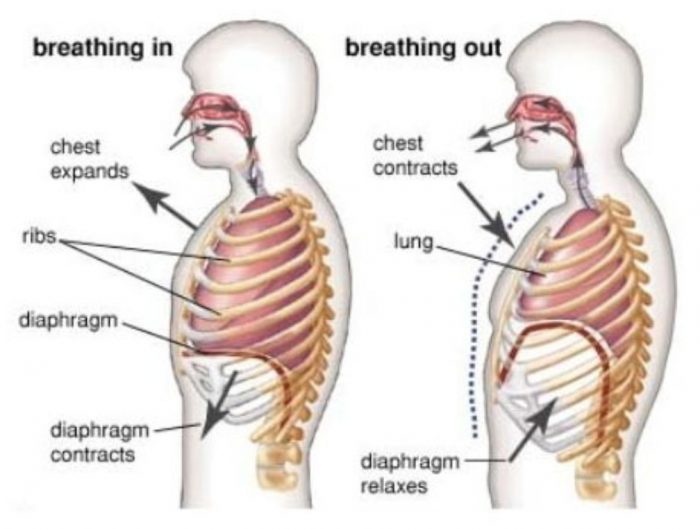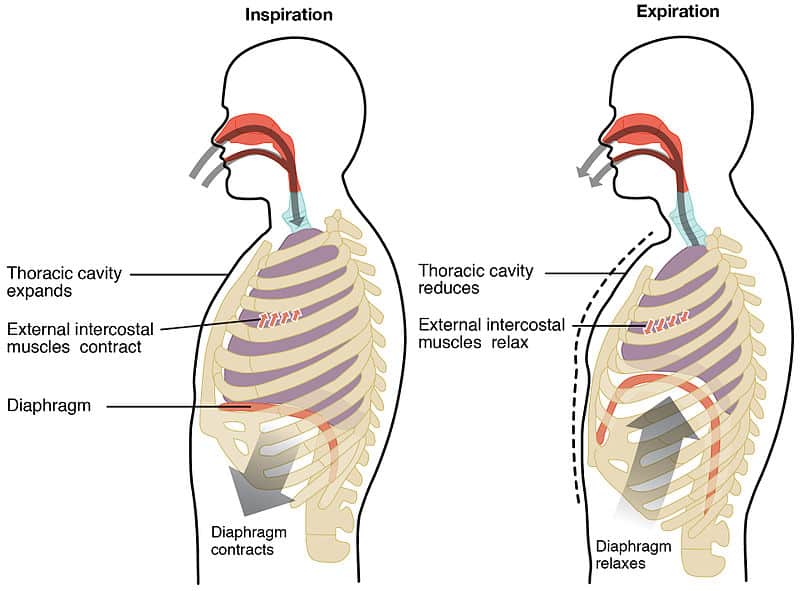The diaphragm returns to a dome shape. In animals it is the movement of air from the lungs out of the airways to the external environment during breathing.

How To Sing From Your Diaphragm Healthy Voice With Katarina Vocal Lessons Singing Lessons Singing Tips
Tidal volume TV is the amount of air that normally enters the lungs during quiet breathing which is about 500 millilitersExpiratory reserve volume ERV is the amount of air you can forcefully exhale past a normal tidal expiration up to 1200 milliliters for menInspiratory reserve volume IRV is produced by a deep inhalation past a tidal inspiration.

. When a person exhales the diaphragm and muscles between the ribs relax and make the chest cavity smaller. Air from inside the lungs high pressure is pushed out into the atmosphere low pressure to make the pressures equal. The diaphragm relaxes intrapulmonary pressure increases air flows out c.
Inspiration is the process that causes air to enter the lungs and expiration is the process that causes air to leave the lungs Figure 2233. Select ALL the statements that accurately describe the interplay between organ systems. When you breathe out or exhale your diaphragm relaxes and moves upward into the chest cavity.
There the oxygen in the blood moves from blood vessels into surrounding tissues. Expiration is the phase of ventilation in which air is expelled from the lungs. A mode of breathing that occurs at rest and does not require the cognitive thought of the individual.
Lung volumes decrease intrapulmonary pressure increases. What is carbon dioxide and water are excreted here during exhalation. Which best describes what happens during exhalation.
Expiration aided by contraction of abdominal musclesand. The diaphragm relaxes intrapulmonary pressure increases air flow out. Create pressure gradient during inhalation compartementalization of organs in thoracic cavity reduce friction between memrbanes.
Pulmonary ventilation comprises two major steps. The intercostal muscles between the ribs relax causing the area of the chest cavity to reduce. Pressure to 30 mmHg or higher.
The intercostal muscles between the ribs also relax to reduce the space in the chest cavity. A Fruits work with leaves to produce sugars using photosynthesis. The diaphragm contracts intrapulmonary pressure decreases air flows out.
As the thoracic diaphragm relaxes during exhalation it causes. During eupnea also referred to as quiet breathing the diaphragm and external intercostals must contract. This happens due to elastic properties of the lungs as well as the internal intercostal muscles which lower the rib cage and decrease thoracic volume.
A the diaphragm contracts intrapulmonary pressure increases air flows out b the diaphragm relaxes intrapulmonary pressure decreases air flows out c the diaphragm relaxes intrapulmonary pressure increases air. During exhalation the lungs expel air and lung volume decreases. During exhalationthe diaphragm moves upward while the rib cage moves downward so it goes back.
The various types of breathing specifically in humans include. Which best describes what happens during exhalation. Such as the scalenes and sternocleidomastoid internal intercostal muscles increases intrapulmonary.
The air from the lungs then flows out of the airways to the outside air. The diaphragm relaxes intrapulmonary pressure increases air flows out. What happens during the exhalation phase of breathing.
The diaphragm contracts intrapulmonary pressure increases air flows out b. Air pressure in the thorax INCREASES and becomes GREATER than the air pressure outside the body. The pathway for exhalation is the movement of air out of the conducting zone to the external environment during breathing.
The decrease in the volume of the chest cavity increases the pressure to a level that is higher than the air pressure outside. Expiration also called exhalation is the flow of the respiratory current out of the organism. Decreases intrapulmonary pressure to -20 mmHg or.
The diaphragm relaxes intrapulmonary pressure decreases air flows out d. Indicate which of the following best describes what happens during exhalation. Thorax volume DECREASES during EXHALATION.
The LUNGS is the location of where Carbon Dioxide and. During the long breath exhalation create friction in the throat region. Which structures enter the lung at the hilum.
Which of these happens during exhalation. During exhalation the diaphragm moves up and ribs move downwards and inwards decreasing the space in the chest cavity this increases the air pressure inside the lungs and forces the air out of the lungs. Exhaling is expelling used air from the lungs.
Which of the following best describes what happens during exhalation. Exhalation is the flow of the breath out of an organism. A respiratory cycle is one sequence of inspiration and expiration.
Eventually the area in the chest reduces and carbon dioxide-rich air is. The purpose of exhalation is to remove metabolic waste primarily carbon dioxide from the body from gas exchange. The intercostal muscles expand.
It is initiated by relaxation of the inspiratory muscles. Diaphragm relaxes to return to its resting position reducing the superiorinferior dimension of the thoracic cavity. Air moves from the environment to the alveoli.
Which of the following best describes what happens during exhalation. Which best describes what happens during exhalation. Airway resistance in the lungs is usually controlled by changing the diameter of which of the following.

Rate Of Breathing Science Year 4 Science Quizizz

Breathing Class 7 Respiration In Organisms Science

What Are The Mechanics Of Breathing

Mechanics Of Breathing Inspiration Expiration Teachmephysiology
0 Comments